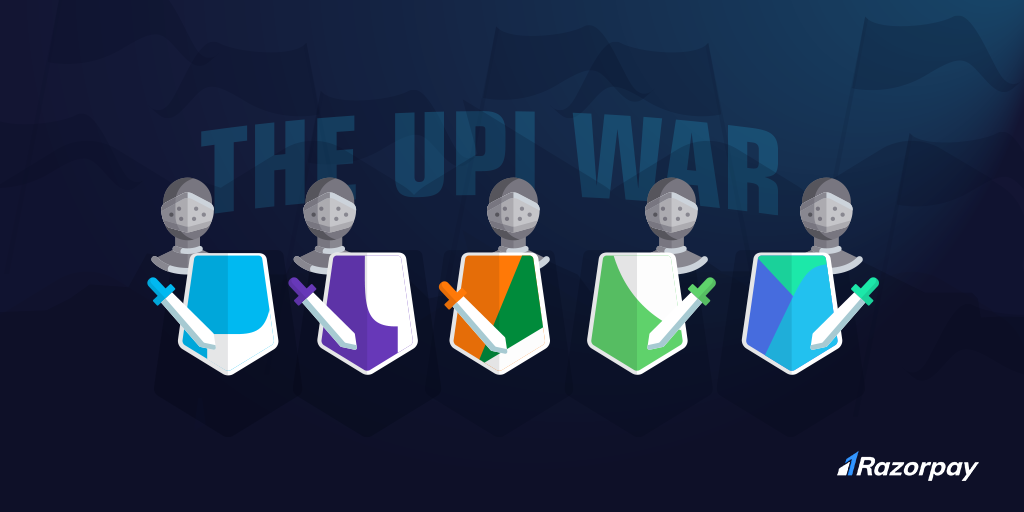At Razorpay we have always believed that UPI would be a game changer for the Indian payments space; even more than Wallets. We were the first payments processor in India to provide this as a payment option to merchants at checkout, in September 2016 (even before demonetization).
You can read about our review of the first year post this launch for a better understanding of this payment mode.
Fast forward two years. Today, there is a renewed focus on UPI, after the NPCI released very impressive numbers on its growth over the past months. Players such as PhonePe and Paytm have claimed their leadership in this niche; with regards to users and adoption. Before jumping into the analysis, let’s understand different types of UPI payments a bit.
Types of UPI Payments
UPI transactions are typically both P2P (money transfer between people) and P2M (money transfer between people and merchants). As a payments platform, we only see P2M transactions on a large merchant base, from many sectors, including big players like IRCTC (Razorpay is the sole provider of UPI as a payment option here).
To push adoption, UPI apps have provided their users with incentives like discounts and cashbacks. The growth in usage is proof that they are working. However, it’s easy to “game” these incentives in P2P payments where people can make payments to themselves or friends/family, just to avail some cashbacks or other benefits.
This is why we believe that P2M payments are a better reflection of UPI usage trends because there is an intent to purchase something along with the payment.
So let’s look at some numbers from our platform and see what we can conclude about adoption. Before starting, we do not claim to represent the entirety of available data but as one of the largest processors of UPI payments; we have a considerable amount of visibility.
Average Ticket Value and What We Learned From It
We first looked at the Average Ticket Value (ATV) for different payment modes across Razorpay.

It’s obvious that Wallets and UPI ATVs are similar (around 1,000-2,000), so clearly consumers are making the same kind of low-value transactions using both UPI & Wallets and higher value ones using Cards, Net Banking etc. One side-note here is that the ATV is also significantly larger than the average ticket value seen for this payment mode on a national scale.
This, according to RBI & NPCI data, currently stands at INR 1116 as for the month of February 2018. Both things put together clearly point out the relatively lower ticket sizes that must be there for P2P transactions on UPI.
The growth in UPI has generally been synonymous with a decline in the number of wallet transactions.

Quite clearly there is a clear shift away from Wallets, with a dramatic increase in this trend between January and February of 2018.
As you can see in the last bar, we also dug out these numbers for the first week of March, after the new stringent KYC norms for Wallets were put in place. And just as we expected – there is an even bigger move away from Wallets.
Disclaimer – PayTm as a Wallet option is not available on Razorpay and hence is outside the scope of this analysis.
Wallets and UPI are directly competing with each other for users. And in the past few months, the latter has clearly been winning.
UPI Adoption Statistics Across Cities
Another item we have always been interested in is how UPI traction is growing outside of Metros & Tier 1 cities.

Adoption is increasing as the marketplace for UPI apps is heating up. In past 1 year, we have seen Tier 2 & Tier 3 cities participation grow by close to 10% each.
Considering the fact that volumes have grown all across as well, this suggests that people in Tier 2 & Tier 3 cities have started to adopt this new payment mode in a big way. This is great news as traditionally these geographies have not shifted over to other modes of digital payments as much.
Lastly – there’s been a lot of discussions on which UPI apps command the leadership positions. We analyzed the share of apps by volume across all UPI transactions on our platform.

UPI vs. Wallets: The Spoils of the War!
Surprised? While a lot of focus in the past week has been on the banks and technology companies like PhonePe, PayTm and Google Tez, BHIM is the clear leader with almost half the market share. Launched in 2016 by the NPCI with support from the government of India – BHIM, the poster app of Digital India, has clearly found favor among the Indian consumers.
The battle among app providers is only set to get more intense. We expect banks, wallet companies and tech powerhouses like Google and WhatsApp to get involved. However, they will have a lot of ground to catch up with BHIM.
Awareness has always been a huge problem in the adoption of digital payments in India. And having the Prime Minister introducing the BHIM app to thousands of people has clearly helped them capture a market others are striving to capture.
The success of UPI and BHIM has clearly shown what can be achieved with the involvement of the policymakers and leaders of the country, in the push towards a Digital India.
Even after an exciting couple of months, we have barely scraped the surface of where UPI can go. More updates and analysis to follow.
Related Read: What is the difference between UPI and BHIM?
Further reading:


